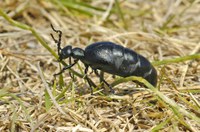High Numbers of Blister Beetles in Hay a Danger for Livestock
(Click the image below to view a high-resolution image that can be downloaded)
This year’s dry weather is increasing the blister beetle threat to cattle and other livestock, North Dakota State University specialists say.
“Blister beetles tend to be more numerous when grasshopper populations are high because the immature stage of blister beetles feeds on grasshopper eggs, and we have higher numbers of grasshoppers in drought years like 2021,” NDSU Extension entomologist Jan Knodel says.
Most blister beetle species produce one generation per year. They lay their eggs in soil from late summer into early fall and overwinter as larvae. They typically emerge in early to midsummer. Blister beetles are very mobile and tend to congregate in large numbers in small areas of the field.
Adult blister beetles are attracted to blooming alfalfa fields and weeds (goldenrods, dandelions). Adults are active June through September and will feed on nectar and pollen, and devour leaves, stems and flowers.
“Blister beetles produce a poison called cantharidin, which is toxic to people and livestock, especially horses, but cattle and sheep also can be poisoned,” Knodel says. “Cantharidin oil is released when beetles are crushed, and even dead beetles have high levels of the toxin.”
Symptoms of toxicity in horses include sores on the tongue and in the mouth, depression, colic, sweating, diarrhea, blood in the feces and frequent urination. Cattle also may exhibit sores in their mouth.
Hay infested with blister beetles is a big concern for hay producers and livestock owners.
“Levels of toxicity to beef cattle have not been identified,” NDSU toxicologist Michelle Mostrom says. “The amount of cantharidin produced by blister beetles varies by species, and male blister beetles produce higher amounts than female blister beetles.”
Only 30 to 50 blister beetles could be lethal to horses, Knodel says.
Blister beetles feed for a short period of time and then migrate to other areas of a field or to new fields. After alfalfa is cut, they often move into blooming canola and other blooming field crops.
Hay fields adjacent to rangeland pastures are at higher risk for blister beetle infestations due to typically higher grasshopper populations in rangeland pastures.
Here are some ways to reduce the threat of blister beetles:
- Control blooming weed hosts near or in alfalfa fields.
- Cut alfalfa at less than 10% bloom and/or late in the season (mid-August to early September).
- Check fields 24 hours prior to cutting to ensure that new swarms of blister beetles have not re-infested the fields.
- Allow cut hay to fully dry before raking to encourage the beetles to move out of the hay. Raking may dislodge dead beetles from hay; however, the potential still exists for cantharidin in the hay.
- Scout harvested hay and underneath windrows closely for blister beetles and allow blister beetles to move out of drying hay before baling. Turning the windrows may be helpful to get blister beetles to move out.
- Use equipment without hay conditioners or crimpers that may crush blister beetles because the crushed beetles can contaminate the hay.
“Even tractor tires can crush blister beetles in hay when turning equipment around,” says Karl Hoppe, Extension livestock systems specialist at NDSU’s Carrington Research Extension Center. “Cut hay with a sickle bar or rotary mower that allows blister beetles to move out of hay after cutting. If large numbers of blister beetles are observed in spots during harvesting, it is best to quit harvesting and allow blister beetles to move out of the way or go around them.”
Janna Block, Extension livestock systems specialist at NDSU’s Hettinger Research Extension Center, has this advice: “If blister beetles are suspected in harvested hay, it is best not to feed it. Don’t force livestock to eat hay contaminated with blister beetles. Cantharidin is a stable compound, and levels will not be reduced during storage.
“It can be difficult to detect blister beetles in harvested hay because beetles may not be whole,” she adds. “Also, they may not be present in every bale due to the insects’ tendency to swarm, which means that it is possible that only bales from certain areas of the field may be infested.”
Knodel says, “Chemical control is generally not recommended at harvest because dead beetles could be incorporated into cured hay instead of falling onto the ground.”
Grinding hay containing blister beetles and then mixing with other feeds will dilute the cantharidin but won’t get rid of it.
NDSU Agriculture Communication - July 1, 2021
Source: Karl Hoppe, 701-652-2951, karl.hoppe@ndsu.edu
Source: Janna Block, 701-567-4323, janna.block@ndsu.edu
Source: Jan Knodel, 701-231-7915, janet.knodel@ndsu.edu
Source: Michelle Mostrom, 701-231-7529, michelle.mostrom@ndsu.edu
Editor: Ellen Crawford, 701-231-5391, ellen.crawford@ndsu.edu


